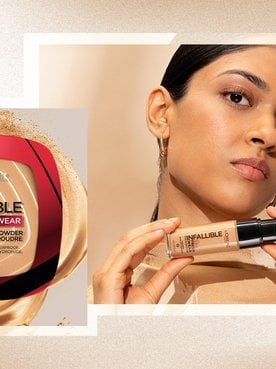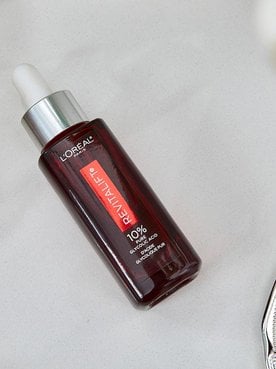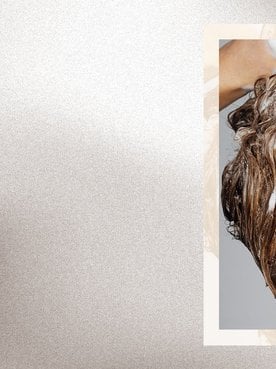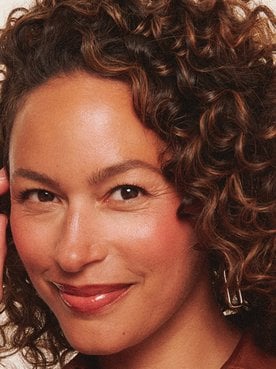Low porosity hair requires specific care to ensure your strands remain hydrated without feeling weighed down. Haircare is not one-size-fits-all. If you have low porosity hair, products designed to hydrate your drier strands—like rich oils or heavy conditioners—may make your strands feel limp. This may prompt you to use lighter-weight options, but those may not provide enough nourishment to fully moisturize your hair. If you struggle to understand what is low porosity hair, it can feel like a no‑win cycle.
Fortunately, it’s not as confusing as it may sound. The key to mastering low-porosity hair care is simply knowing what low-porosity hair products to use and how. It’s also important to know what not to use on low porosity hair. We’ll explain it all and share our top tips ahead. Keep scrolling for your all‑in‑one guide to caring for low porosity hair.
Shop the Products
What Is Low Porosity Hair?
Low porosity hair is structured similarly to a sponge—each strand has tiny pores that allow moisture to enter (and escape). What is low porosity hair in simple terms: porosity refers to how well your hair absorbs and retains moisture, and low porosity hair has a tightly packed cuticle that slows absorption and evaporation.
If you need a visual, it can be helpful to think of your hair cuticles as shingles on a roof. When the cuticles are lifted, the hair is more porous and absorbs moisture more readily; when the cuticles lie flat and tight—as with low porosity hair—moisture has a harder time getting in or out. In a quick comparison of low vs. high porosity hair, high porosity strands drink up products fast but lose moisture quickly, while low porosity hair takes longer to absorb but holds on once hydrated.
Anyone can have low porosity hair, but genetics set most of the baseline. Day-to-day factors can exacerbate its “low porosity” effect: layers of product can coat the strand, hard water can leave deposits, and frequent heat styling can press the cuticle flat. When the surface is tight or coated, moisture has a harder time getting in, so your hair may feel dryeven when you’re applying hydrating products.
Key characteristics of low porosity hair:
- Beads of water: Droplets sit on the surface before slowly sinking in.
- Takes time to wet/dry: Hair resists water at first and air‑dries slowly.
- Product sits on top: Creams and oils can feel like a film or cause buildup.
How To Know if You Have Low Porosity Hair
A clear indicator of low porosity hair is that it feels hard to moisturize. No matter how much water or conditioner you use, hydration seems slow to take, and hair can take a long time to air‑dry. You may also notice more product residue on your strands or scalp versus other hair types.
If you want to reallyunderstand your hair porosity, there are a few easy tests you can try at home:
- Float test: Start with a freshly washed, product‑free strand and a clear glass of room‑temperature water. Watch for two to three minutes: low porosity hair usually floats at the surface or sinks very slowly, while high porosity hair sinks quickly.
Hard‑water minerals or leftover conditioner can skew the result, so clarify first for the most accurate read.
- Spray test: On clean, dry hair, mist water. If droplets bead up and sit on top for 30 seconds or more, that points to low porosity hair. If they absorb almost on contact, porosity is higher.
Oils and leave‑ins can make any hair bead temporarily, so repeat on a product‑free section if needed.
- Buildup check: Notice if stylers sit on the surface,feel waxy, or leave a film and white residue when you apply more. On low porosity hair, that often means the cuticle is resisting absorption. If it happens mostly after several heavy layers, it’s likely plain buildup.
A periodic clarifying wash can reset slip so hydrators and conditioners work better.
Quick checklist:
- Water beads stay on the surface of your hair? → yes/no
- Does your hair take noticeable time to get wet? → yes/no
- Do products feel heavy or sit on hair? → yes/no
If you answered "yes" to the three questions, then there's no doubt you have low porosity hair.
What Are The Best Low-Porosity Hair Products?
Choosing the right low-porosity hair products helps moisture get in and stay comfortable without weight. Here’s what to look for—and what to avoid.
What to look for
- Lightweight, water‑based formulas: Gels, milks, and lotions absorb more readily than thick butters, so moisture can sink in without leaving a heavy film.
- Humectants: Ingredients like glycerin, aloe, and honey draw water to the hair shaft, giving soft, cushiony hydration without weight.
- Regular clarifying: A periodic clarifying shampoo removes residue and hard‑water minerals so strands can better absorb hydration and your stylers.
What to avoid and why
- Heavy oils and butters (e.g., coconut oil, shea): These rich textures tend to sit on the surface of low porosity hair, forming a coating that makes it harder for water‑based moisture to penetrate. Over time, that film can collect residue, dull shine, and leave strands feeling heavy rather than hydrated.
- Heavy silicones and waxy stylers: Non‑water‑soluble films can build up on the strand, which can make hair look flat and reduce how well conditioners and treatments absorb. Without regular removal, shine fades and the scalp can feel coated, especially on fine or tightly packed cuticles.
- Excess protein: Many with low porosity hair already have a tight, compact structure, so frequent protein treatments can tip the balance. Too much protein leaves hair rigid and less flexible, which can make ends feel rough and more prone to snapping during detangling.
How To Care for Low Porosity Hair
While it can be hard to get moisture into your low porosity hair, the right approach makes a visible difference. Consider these tips below to get started:
Skip the hot water
Long, steaming showers can leave strands feeling drier by lifting natural oils and roughing up the surface. Lukewarm water helps keep the cuticle smooth so hydration stays where you want it. Make this your go‑to temperature on every wash day, and finish with a short, cooler rinse if your hair likes extra shine.
Try a hair steamer
Gentle steam encourages the cuticle to relax, which helps conditioners and masks move in more easily. This matters for low porosity hair because a tight surface can slow absorption. Use a steamer for 10–15 minutes before or over a mask once a week or every other week, and skip if hair starts to feel over‑soft.
Use a moisturizing hair care system
A consistent shampoo‑and‑conditioner duo keeps hydration steady without weight. For your in‑shower lineup, try the L’Oréal Paris EverPure Sulfate Free Moisture Shampoo for Dry Hair and the L’Oréal Paris EverPure Sulfate Free Moisture Conditioner for Dry Hair. These low-porosity hair products promote softness and shine, and help protect color. Two to three times per week, addL’Oréal Paris Elvive Hyaluron + Plump Flash Hydration Wonder Water, Sulfate‑Free between shampoo and conditioner for fast, lightweight hydration.

Shop the Products
Try the LCO method
The liquid‑cream‑oil approach layers from lightest to richest, so hair can take in hydration step by step. It matters for low porosity hair because lighter textures get a head start, and a small amount of oil helps seal without heavy buildup. Use this order on styling days. In humid weather, you may prefer just liquid‑cream, while in very dry air, the oil step can help your ends feel cushioned.
Deep condition regularly
A weekly deep‑conditioning moment adds slip and longer‑lasting moisture—this low-porosity hair product is key when absorption is slow. Reach forL’Oréal Paris EverPure Sulfate‑Free Moisture 21‑in‑1 Leave‑In Conditioner as an intensive, lightweight leave‑in session after wash day to boost softness and shine without weight. If hair feels coated, clarify first, then deep condition to help the benefits sink in.
Use hair serums
Hydrating serums smooth the outer layer so hair feels softer to the touch and looks shinier. We likeL’Oréal Paris Elvive Hyaluron + Plump Moisture Plump Serum, a low-porosity hair product which features hyaluronic acid to help hair stay moisturized for up to 72 hours with no greasy feel. Use on mid‑lengths and ends on damp hair to lock in hydration, or on dry hair to tame rough patches between washes.

Shop the Products
Cover your hair at night
Cotton can pull moisture from strands and add friction while you sleep, which can rough up the surface over time. A silk or satin bonnet—or switching to a silk/satin pillowcase—helps reduce moisture loss and keep styles smoother. Make this a nightly habit to protect your low porosity hair between wash days.
Try a pre‑shampoo treatment
Getting moisture into low porosity hair can be easier with a pre‑shampoo step that supports the hair’s structure. ApplyL’Oréal Paris EverPure Bond Strengthening Pre‑Shampoo Treatment before washing with a 14% Bonding Care Complex with citric acid to support weak bonds. Use 1–3 times per week based on damage, then follow withL’Oréal Paris EverPure Sulfate Free Bond Repair Shampoo with Citric Acid andL’Oréal Paris EverPure Sulfate Free Bond Repair Conditioner with Citric Acid to cleanse, replenish, and smooth.

Shop the Products
Use a clarifying treatment
After days of styling, buildup can collect at the scalp and make absorption harder. Refresh with clarifying low-porosity hair products such as the L’Oréal Paris Elvive Hyaluron + Pure Oil‑Erasing Serum for Oily Hair once a week or every 1–2 weeks as needed to lift residue and minimize excess oil without stripping.
If you feel like you need a complete reset, opt for the L’Oréal Paris EverPure Sulfate‑Free Clarifying Shampoo with Antioxidants instead, a color-safe clarifying shampoo with a non-stripping formula that removes product buildup and hard water exposure to restore strands. Pair your cleanser with lighter conditioners that restore and detangle without leaving a film, such as theL'Oréal Paris EverPure Sulfate-Free Restoring Conditioner with Antioxidants, which replenishes your strands with moisture after washing.
Shop the Products

What To Avoid for Low Porosity Hair
A few smart skip‑list tweaks can be just as important as the products you use. Because low porosity hair tends to hold onto coatings and heat, certain habits can shut moisture out and dull your shine. Use the guide below to keep your routine light, clear, and absorption‑friendly.
Product‑related avoidances
- Heavy oils/butters: These rich textures often sit on the surface of low porosity hair, forming a coating that makes it harder for water‑based moisture to penetrate. Over time, that film can collect residue, dull shine, and leave strands feeling heavy rather than hydrated. If you love oils, reserve a tiny drop for the very ends over damp hair rather than roots.
- Heavy silicones/waxy stylers: Non‑water‑soluble films can build up on the strand, which can make hair look flat and reduce how well conditioners and treatments absorb. Without regular removal, shine fades and the scalp can feel coated, especially on fine or tightly packed cuticles. If you prefer slip, look for lighter, water‑rinsable options and reassess build‑up every couple of weeks.
- Too much protein: Many with low porosity hair already have a tight, compact structure, so frequent protein treatments can tip the balance. Too much protein leaves hair feeling rigid and less flexible, which can make ends feel rough and more prone to snapping during detangling. Balance occasional protein with humectants and emollients, and space treatments a few weeks apart.
Routine and environmental avoidances
- Overly hot water: Very hot water can encourage dryness and a rough feel by tightening and ruffling the surface. Stick to lukewarm on most wash days and finish with a brief, cooler rinse if your hair likes extra shine. This helps hydration stay where you want it.
- Frequent high heat without moisture: Back‑to‑back heat styling can make hair feel tighter and less flexible. Give hair no‑heat days between hot tools and always pair heat with hydrating prep to keep comfort and movement. Spacing heat use through the week helps maintain softness.
- Skipping clarifying: Buildup from stylers and minerals makes absorption harder over time. Add a clarifying step every 1–2 weeks (or after heavy styling) so hydrators can do their job and slip returns. Follow with conditioner to keep lengths cushioned.
- Cotton pillowcases: Cotton can pull moisture from strands and add friction as you sleep. Satin or silk pillowcases (or a bonnet) are gentler and help styles last longer. This small switch supports moisture retention between wash days.
Low Porosity Hair FAQs
Is low porosity hair healthier than other types?
Low porosity hair isn’t automatically healthier—it simply behaves differently. Its tight cuticle resists moisture at first, so care is about patience, light layers, and regular clarifying to keep absorption smooth.
Why does my low porosity hair feel dry even after applying products?
Absorption happens slowly with low porosity hair, and heavy products can sit on top. Choose lighter, water‑based options, add humectants, and clear buildup regularly so hydration can move in.
Can I change my hair’s porosity?
Porosity can shift with damage (for example, when you bleach or use high-heat styling), but your baseline is largely genetic. You can’t “flip” low porosity hair to high, yet smart routines help it stay hydrated, soft, and flexible.
Next Up: How to Care for High Porosity Hair
Photo courtesy of L’Oréal Paris







